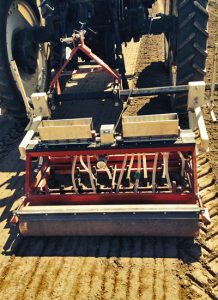by Matthew McDermott, production manager, and Rob Jordan, post harvest manager
For many people, mixed baby greens are a popular salad choice all year round. As part of the CMFC food production, mixed baby greens are grown for the local wholesale and retail outlets from May-November. As part of a 2012 specialty crop grant, and in collaboration with WSU, CMFC set about identifying efficient and economical production methods for this crop. Although the process continues to evolve, we’ve narrowed in on a mechanized system that provides a relatively consistent, high quality product for the salad eaters of the Puget Sound community.
Bed Preparation:
Early season baby greens are sown under the cover of a permanent hoop house and as the soil warms, production shifts to field-based beds. In both locations, the cost of intensive hand weeding quickly drives up the cost of production and can leave you with a losing hand. Time and flame weeding are used to help minimize hand weeding. Standard primary cultivation involves discing and chisel plowing. From there, a rototiller is used to create a fine seed bed.
Water is introduced (rainfall or irrigation) after the rototiller, which commences the clock. Depending on soil temperatures, we generally wait 7-10 days for the 1st flush of weeds to germinate. At this “white thread” stage, the flame weeder is pulled over the bed and heats the plants cells to the point of collapse. They wilt and die. But alas, another round of weeds is ready to germinate. Waiting another 4-6 days allows for this next round to flush and fall to the flamer. The idea here is to flush weeds in the top couple inches of soil without disturbance, which would bring another round of seeds to the surface.
Seed Sowing and Irrigation:
Seeds are sown immediately after the 2nd flaming. We use a tractor mounted, Sutton mechanical seeder that sows 24 rows per 68” bed, about 1” apart in row. The seeds are sown very close to the soil surface to promote quick germination. We source seed from the Skagit-based seed company, Osborne seeds. During the spring and fall, seed mixes consist of brassicas, such as kale, choi, and mustard. In the summer, a mix of lettuce leaves are used. In the heat of the summer, overhead irrigation comes on for 15 minutes, every 2 hours from 10am – 8pm.
Harvest and Post-Harvest:
Although temperature and daylight play a big factor, brassica mixes can be ready as soon as 28 days from sowing and lettuce as soon as 32 days from sowing. A two-person team pushes a mechanical harvester that resembles a band saw with a conveyor belt. 200lbs of baby greens can be harvested in about 1 hour as they tumble into Rubbermaid totes. The baby greens are transported from the field to the cooler while the processing room is prepared. Because it’s a ready to eat product, extra care is taken to wash and pack in a facility that is licensed by WSDA. The greens run across a conveyor belt and into two wash tanks. After the wash tanks, the greens are dried in electric spinners and packed into 2.5lb bags for delivery.
It’s an intense process to produce those delicate greens. Next time you enjoy a salad, take a minute to think about how it arrived on your plate.


